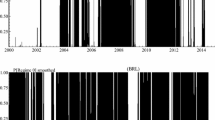Abstract
In this paper, we have interested to testing the contagion exists that is caused by the sub-prime crisis, in order to distinguish between the cases of interdependences and “shift contagion” during this crisis. The analysis was conducted on a sample of four highly transition countries: Brazil, Russia, India and china, and the market source of crisis, taking into consideration the index as an aggregate indicator of financial market. The study of contagion is based on the tests of adjusted correlation coefficient and the non-linear error correction models. Indeed, these techniques reject the contagion hypothesis between these markets in order to conclude “no contagion, only interdependence”.
Similar content being viewed by others
References
Allen F, Gale D (2004) Financial intermediaries and markets. Econometrica 72(4):1023–1061
Baig T, Goldfajn I (1999) The Russian default and the contagion to Brazil, IMF Working Paper, WP/00/160
Brunnermeier MK, Pedersen LH (2005) Predatory trading. J Fin 60(4):1825–1863
Brunnermeier MK, Pedersen LH (2009) Market liquidity and funding liquidity. Rev Fin Stud 22(6):2201–2238
Collins D, Biekpe N (2002) Contagion: a fear for African equity markets? J Econ Bus 55(3):285–297
Corsetti G, Pericoli M, Sbracia M (2002) Some contagion, some interdependence, more pitfalls in tests of financial contagion. J Int Money Fin 24(8):1177–1199
Dickey DA, Fuller WA (1981) Distribution of the estimators for autoregressive time series with a unit root. Econometrica 49(366):1057–1072
Engel R, Granger C (1987) Co-integration and error correction representation, estimation and testing. Econometrica 55(2):251–276
Escribano A, Pfann G (1998) Non-linear error correction, asymmetric adjustment and cointegration. Econ Model 15(2):197–216
Forbes K, Rigobon R (2000) Contagion in Latin America: definitions, measurements and policy implications. NBER Working Paper
Forbes K, Rigobon R (2002) No contagion, only interdependence: measuring stock market co-movement. J Fin 57(5):2223–2261
Glick R, Andrew R (1999) Contagion and trade why are currency crises regional? J Int Money Fin 18(4):603–617
Granger C, Lee TH (1989) Investigation of production, sales and non-symmetric error correction models. J Appl Econ 4(1):145–159
Kaminsky G, Reinhart C (1999) Bank lending and contagion: evidence from the Asian crisis. NBER 10th Annual East Asia Seminar on Economics
Kaminsky G, Reinhardt C, Vegh C (2003) The unholy trinity of financial contagion. J Econ Perspect 17(4): 51–74
Kodres L, Pritsker M (2002) A rational expectations model of financial contagion. J Finance 57(2): 769–800
Loretan M, English WB (2000) Evaluation “correlation breakdowns” during periods of market volatility. International Finance Discussion Paper No. 658, Federal Reserve Board, Washington, DC
Masih A, Masih R (1999) Are Asian stock market fluctuations due mainly to intra–regional contagion effects? Evidence based on Asian emerging stock markets. Pac Basin Fin J 7(3–4):251–282
Masson P (1998) Contagion: monsoonal effects spillovers, and jumps between multiple equilibria. IMF Working Paper wp/98/142, Washington DC, International
Omri A, Ghorbel-Zouari S (2011) International financial contagion of the US sub-prime crisis: evidence through the adjusted correlation test and non-linear error correction models (ECM). Int J Monet Econ Fin 4(2):135–149
Author information
Authors and Affiliations
Corresponding author
About this article
Cite this article
Omri, A., Frikha, M. No Contagion, Only Interdependence During the US Sub-Primes Crisis. Transit Stud Rev 18, 286–298 (2011). https://doi.org/10.1007/s11300-011-0210-6
Received:
Accepted:
Published:
Issue Date:
DOI: https://doi.org/10.1007/s11300-011-0210-6




